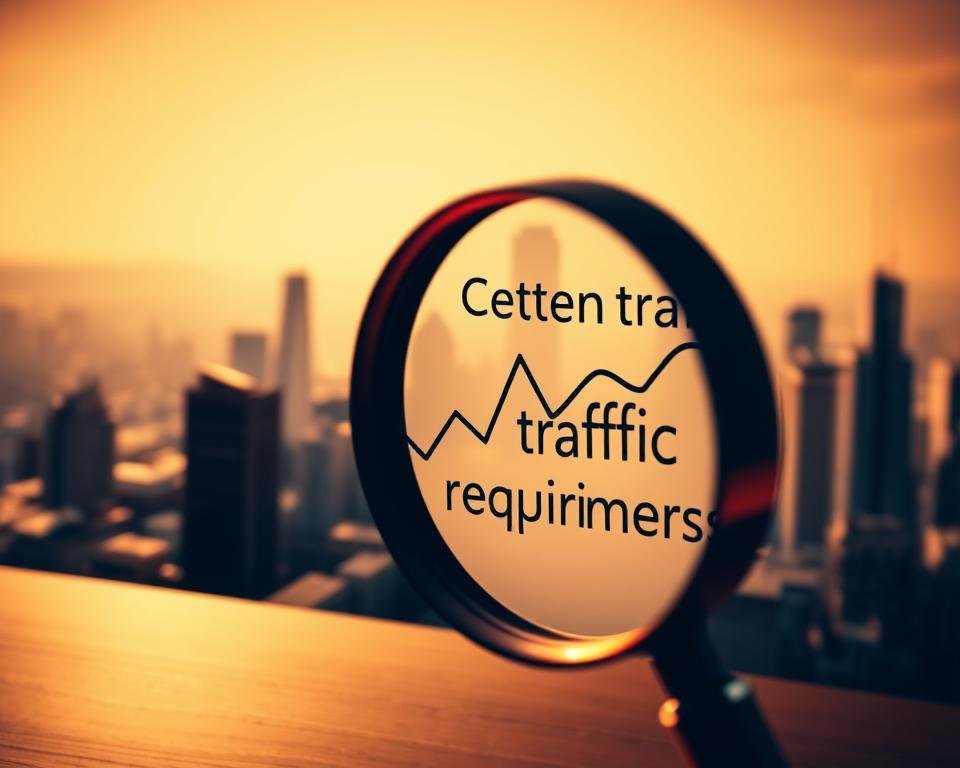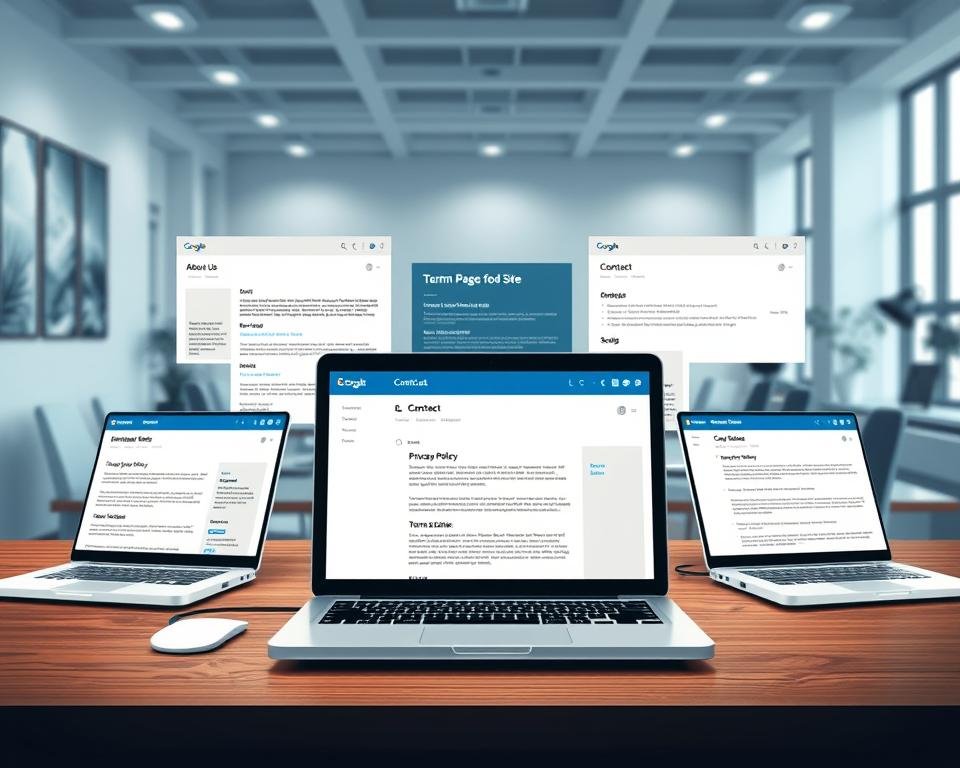Getting rejected by AdSense can be really tough for bloggers. I’ve looked into why this happens and found ways to fix it.
It’s important to know why you might get rejected. This way, you can make sure your blog follows AdSense’s rules and gets approved. I’ve found key areas to focus on to avoid getting rejected.
Key Takeaways
- Ensure your blog complies with AdSense’s content policies.
- Check for policy violations that may lead to rejection.
- Make sure your blog has a clear and compliant privacy policy.
- Verify that your website is accessible and user-friendly.
- Review AdSense’s guidelines to avoid common mistakes.
Understanding Google AdSense and Its Guidelines
Google AdSense lets bloggers make money by showing ads on their sites. To use AdSense well, bloggers need to know what it is and how it works.
What Is Google AdSense?
Google AdSense is a Google program for website publishers. It lets them show ads that match their site’s content. Bloggers can make money when people click on or view these ads.
Google looks at the website’s content to pick the best ads. This way, ads match what visitors like, making them more likely to engage.
Importance of AdSense for Bloggers
For many bloggers, AdSense is a key way to earn money online. By adding AdSense to their sites, bloggers can get a steady income. This income helps them keep blogging.
Getting AdSense approval is key for bloggers to make money from their sites. Knowing and following AdSense rules helps avoid rejection. This lets bloggers focus on making great content and earning from AdSense.
To get past AdSense rejection and get approved, bloggers must understand and follow AdSense’s rules. This boosts their credibility and improves their site for visitors.
Common Reasons for Rejection
AdSense rejections often come from a few main issues. Bloggers can fix these problems. Knowing these common mistakes helps your blog meet AdSense’s strict rules.
Lack of Original Content
One big reason for AdSense rejection is not having original content. Google wants unique and valuable content for its readers. Make sure your blog posts are well-researched and offer new insights.
Tips for creating original content:
- Do deep research on your topic.
- Check your content with plagiarism tools.
- Give unique insights that others don’t.
Violating Copyright Policies
Using copyrighted material without permission is another big no-no. This can lead to serious problems. Always use free images and get the right permissions for any copyrighted stuff.
Best practices for copyright compliance:
| Practice | Description |
|---|---|
| Use royalty-free images | Choose images from trusted sources that let you use them for free. |
| Obtain necessary permissions | Get permission before using any copyrighted stuff. |
| Attribute sources correctly | Always give credit to the original creators of the content you use. |
Insufficient Traffic or Engagement
Not enough traffic or engagement can also get you rejected. Google likes blogs with lots of readers. To get more visitors, make great content and share it everywhere.

Restricted Content Categories
Lastly, content in restricted categories can get you rejected. Google has rules for what’s okay for AdSense. Make sure your content fits these rules by staying away from sensitive topics.
Categories to avoid:
- Adult content
- Gambling and lottery
- Violent or extremist content
Quality of Content Matters
High-quality content is a must for AdSense approval. The quality of your blog’s content is key to getting approved. As a blogger, making high-quality, engaging content is very important.
Importance of Quality Over Quantity
Many bloggers think making lots of content is the secret to success. But, quality is more important than quantity. Google AdSense looks for content that is valuable, well-researched, and error-free.
Creating top-notch content boosts your blog’s trustworthiness. It also makes readers more engaged. This can bring more visitors and better AdSense results.
Tips for Creating High-Quality Content
To meet AdSense’s content standards, follow these tips:
- Do thorough research on your topic to offer real insights.
- Write clearly and simply so more people can understand it.
- Check for grammar mistakes by proofreading several times.
- Make catchy headlines that show what your content is about.
- Use the right keywords naturally to boost SEO.

By focusing on these tips, you can make your blog’s content better. This will help you get AdSense approval.
Design and User Experience
To get AdSense approval, bloggers need to focus on a good user experience. A well-designed blog attracts and keeps readers. It also makes Google AdSense more likely to approve your blog.
Importance of a Clean Blog Design
A clean blog design is key to keeping your audience interested. It uses a clear layout, easy-to-read fonts, and colors that match your brand. A clutter-free design makes your content stand out, improving how people feel about your blog.
Think about how easy it is to navigate your blog. Make sure it looks good on all devices. Your blog’s design should match your brand and be easy to read.

Mobile Responsiveness Is Key
Most people now use mobile devices to surf the web. So, having a mobile-friendly blog is a must for AdSense approval. A mobile-friendly design means your blog works well on all devices and screen sizes.
To make your blog mobile-friendly, use flexible designs and media queries. This way, your blog looks great on any screen. Check how your blog looks on different devices to make sure it’s easy to use and looks good.
By focusing on a clean design and making sure it works on mobile, you can boost your blog’s user experience. This can help your blog get AdSense approval. These steps are important Google AdSense blog rejection fixes that can really help.
Incomplete or Missing Information
Google AdSense needs bloggers to have key pages on their site. This is to follow their rules. When you apply for AdSense, make sure you have all the info you need. This helps avoid getting rejected because of missing details.
Necessary Pages for AdSense Approval
To get AdSense approval, bloggers need to have certain pages. These pages are important:
- A clear and detailed Privacy Policy page
- A Contact page with the right contact info
- An About page that tells about the blog and its creator
These pages help follow AdSense rules. They also make the blog better for users and more trustworthy.

The Role of Privacy Policies and Contact Pages
A Privacy Policy page is a must for AdSense approval. It tells users how their personal info is used. A Contact page is also key. It lets users reach out to the blog owner or site manager.
Here’s what each page needs:
| Page | Required Information | Purpose |
|---|---|---|
| Privacy Policy | Data collection methods, user rights, and data protection measures | To inform users about data handling practices |
| Contact | Contact details such as email address, physical address, and contact form | To facilitate communication between users and the blog owner |
By having these important pages, bloggers can boost their chances of getting AdSense approval. They also build trust with their readers.
Ad Placement and Compliance
To fix AdSense blog rejection, knowing ad placement rules is key. It’s not just about looks. It’s also about following Google’s rules to keep your blog eligible for AdSense.
Understanding Ad Placement Rules
Google has rules for where and how ads can be on a website. These rules help improve user experience and stop click fraud. Important guidelines include:
- Ads should be easy to tell apart from content.
- Ads should not be near or between content that might trick users.
- The number of ads per page should not go over Google’s limits.
Knowing these rules is vital for staying compliant. I suggest checking Google’s official AdSense policy page for the latest info.
Common Ad Placement Mistakes
Many bloggers make big mistakes with ad placement, leading to AdSense rejection. Some common errors are:
- Putting ads too close to or in content, making it hard to tell them apart.
- Using misleading text or images that could trick users into clicking ads.
- Having more ads than allowed per page.
To avoid these mistakes, it’s important to know Google’s policies well. Also, check your site’s ad placement often.

By sticking to Google’s rules and avoiding common mistakes, you can boost your chances of AdSense approval. This keeps your blog compliant and earning money.
Key Takeaways:
- Understand and follow Google’s ad placement rules.
- Avoid common ad placement mistakes.
- Check your site often to keep it compliant.
Traffic Sources and Legitimacy
It’s important to make sure your blog’s traffic is real for AdSense approval. Where your blog’s traffic comes from matters a lot. It affects how people see your content and search engines rank it.
Influence of Traffic Sources on Approval
Various traffic sources can change your AdSense approval chances. Organic traffic from search engines like Google is seen as very good. It shows your content is useful to users. But, traffic from shady or fake sources can get you rejected.
Here are some key factors to consider regarding traffic sources:
- Quality over quantity: It’s not just about the number of visitors, but the quality of those visitors.
- Relevance: Ensure that your traffic is relevant to your content niche.
- Diversity: A diverse range of traffic sources can be a positive indicator.
Avoiding Spammy Traffic Sources
To avoid AdSense rejection, stay away from spammy traffic sources. These include:
- Buying traffic from dubious sources.
- Using bots to artificially inflate your traffic.
- Participating in link schemes or other black-hat SEO tactics.
Instead, focus on making high-quality content that draws real visitors. Use real marketing like SEO, social media, and email to get organic traffic.

By understanding and managing your traffic sources well, you can boost your AdSense approval chances. This keeps your blogging healthy and sustainable.
Violating Google’s Terms of Service
Knowing Google’s Terms of Service is key to getting AdSense approved. Google has rules to keep users safe and respectful. Breaking these rules can get your AdSense application denied.
Common Violations to Avoid
Some common mistakes can stop your AdSense application. These include:
- Clicking on your own ads or telling others to do so
- Creating fake clicks or impressions with automated tools
- Putting ads on pages with banned content
- Changing ad codes or sending users to other sites
It’s vital to know these mistakes to avoid them.
Ensuring Compliance with TOS
To follow Google’s Terms of Service, read the guidelines well. Here’s how to do it:
- Read and understand Google’s Terms of Service and AdSense policies
- Check your blog often to see if it follows these rules
- Change your content and ad placement if needed
- Watch your AdSense performance and report any problems

By taking these steps and avoiding mistakes, you can improve your AdSense approval chances. Staying in line with Google’s rules is a continuous effort. It needs careful attention and a strong commitment to following the guidelines.
Building a Strong Brand
Creating a reputable brand is key for bloggers wanting to boost their AdSense blog approval. A solid brand builds trust and credibility with readers. This is vital for getting AdSense approval.
Importance of Branding for AdSense Approval
A strong brand identity can greatly help with AdSense approval. It shows you’re professional and serious about quality content. These are important to AdSense reviewers.
Key benefits of strong branding for AdSense approval include:
- Increased credibility
- Enhanced trust with the audience
- Better content quality
- Improved user engagement
Strategies for Effective Branding
To create a strong brand, bloggers need to focus on being unique and consistent. Here are some strategies:
Developing a unique brand voice: Your brand voice should match your blog’s personality and values. It should connect with your target audience.
Consistent visual branding: Use the same colors, fonts, and images. This makes your brand easy to recognize.
By using these strategies, bloggers can build a strong brand. This not only helps with AdSense approval but also boosts their online presence.
Preparing for AdSense Submission
Before you submit your blog to AdSense, follow some key steps. Make sure your blog meets Google’s guidelines. This will help you get approved faster.
Best Practices Before Applying
Your blog should have top-notch, original content. It should also have a clear privacy policy and a contact page. This lets users reach out to you.
Key best practices include: creating high-quality content, having a user-friendly website design, and following AdSense policies.
- Ensure your blog is fully functional and easy to navigate.
- Provide a clear and concise privacy policy.
- Have a contact page for user inquiries.
Checklist for AdSense Readiness
Here’s a checklist to make sure your blog is ready for AdSense:
| Criteria | Status | Notes |
|---|---|---|
| Original and high-quality content | Yes/No | Ensure content is unique and valuable |
| Clear privacy policy | Yes/No | Make sure it’s easily accessible |
| Contact page available | Yes/No | Provide a contact method for users |
| User-friendly website design | Yes/No | Ensure it’s mobile-responsive and easy to navigate |
By following these steps and using the checklist, you can boost your chances of getting approved for AdSense.
What To Do After a Rejection
A rejection from Google AdSense isn’t the end of your blogging journey. It’s a chance to learn and get better. When you get rejected, it’s normal to feel down. But knowing why you were rejected is key to moving on.
Understanding the Rejection Email
The first thing to do after getting a rejection email is to read it carefully. Google AdSense will tell you why they said no. They might say it’s because of policy violations or inadequate content.
It’s important to take these reasons seriously. You need to fix these problems before you apply again.
Steps to Take Before Reapplying
Before you apply again, you need to fix the problems that caused the rejection. First, check Google’s policies and make sure your blog follows them. This might mean removing banned content, making your posts better, or making your site easier to use.
- Review and rectify policy violations.
- Enhance the quality and originality of your content.
- Improve your site’s user experience and design.
- Ensure compliance with Google AdSense policies.
By doing these things, you can greatly improve your chances of getting approved next time. Remember, being persistent and open to change is important for making money with Google AdSense.
Conclusion: Turning Rejections into Opportunities
Getting an AdSense rejection can feel tough. But, it’s a great chance to learn and make your blog better. Knowing Common Reasons AdSense Rejects Blogs & How to Fix Them is key to doing well.
Learning from AdSense Feedback
When your blog gets rejected, Google tells you why. It’s important to read this feedback carefully. You might need to make your content better, change where ads go, or follow AdSense rules more closely.
Path to Continuous Improvement
To get AdSense approval next time, make sure your content is top-notch and follows Google’s rules. Keep your blog fresh and make it easy for users to enjoy. This will make your blog more credible and attractive to advertisers.
Being proactive and using feedback to improve can turn a first rejection into a chance to get AdSense approval. It’s a big step towards growing your blog.
